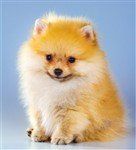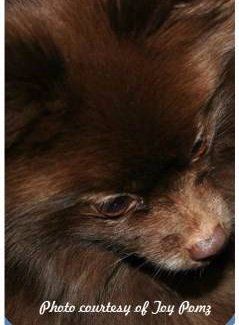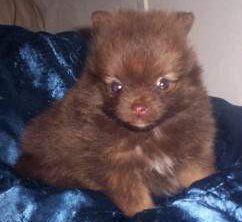Chocolate Brown Pomeranians
Overview
Since the Pomeranian can be found in so many colors and variations, it is not uncommon for there to be some confusion regarding chocolates.
Some refer to chocolate as brown, and this is not wrong, since it is a brown color; however the official terminology will be chocolate. And to say that a Pom is a chocolate brown is not incorrect; however the 'brown' is simply an addition to the description and it is left off when registering the
puppy.
Some of the colors that one may mistake for chocolate are beaver and dark cream.
In addition, aside from solids, a Pomeranian may have another color. Some examples are chocolate and tan, chocolate merle, or chocolate sable.
Why Beaver or Cream Can Be Confused with Chocolate
Cream is a misleading color label. This is because while cream can certainly apply to a Pomeranian that does indeed have a light cream coat, it also encompasses all shades, from light to medium and all the way to a deep, dark coat that anyone could describe as being brown... and therefore, mistakenly think that it is a chocolate Pomeranian.
When deciding coat color, one must look to the pigmentation of the: eye rims, nose, lips, and paw pads. It can be helpful to first look to the nose, since it is the easiest area to determine coloring.
If a Pom has any coat that ranges from a light cream to a tan to a dark brown, yet has a black nose, that Pom is a cream.
Unofficially, one may refer to their Pomeranian as brown, although it is not an official AKC color. And certainly, it makes sense to do so in many cases.
If a Pom is a dark cream (brown) and one refers to their Pom as cream, anyone unfamiliar with this breed may be confused with the vernacular.
Beaver is certainly a type of brown, yet is in a classification all its own. In fact, it is a diluted chocolate. Beaver is a soft, greyish brown hue that had a distinct appearance. Again skin pigmentation comes into play, with these Poms having “self-colored” eye rims, nose, lips and paw pads. Beavers will have light beige to a brown pigmentation.
This is a beaver Pom (left; top on mobile). The telltale sign that this Pomeranian is beaver and not a chocolate is the nose. Notice how the nose is a warm beige color, just like the coat.
If this Pom were chocolate, the nose (and other skin pigmentation) would also be a dark chocolate brown.
What to Look for with a True Chocolate
A true chocolate colored Pom will have a dark brown coat, and importantly, dark brown rims, lips, pads and nose.
Many will think of this coat as being like a Hershey’s bar or a rich, deep brunette. With some, the coat will be lighter, and one may be tempted to call the Pom a cream , however if the pigmentation is not black, it will not be a cream.
Some chocolate coats will have a red tint that brings a mahogany hue; this can be caused by 2 factors: The coat itself may carry the red gene or due to exposure to sunlight, over a period of time, the coat can lighten in this way, developing what is often referred to as a “sun burn” effect (although skin does not need to be affected).
In the latter case, a color-enhancing canine shampoo can tone down the reddish highlights and bring back the deeper brunette, should one desire to do so.
Coats can hold what some refer to as a “black chocolate”, this often refers to Poms with a brown so dark, it almost appears to be black; however since this is not an official coloring, the dog will be registered as chocolate, as long as the nose, eye rims, lips and pads are any shade of brown.
Technically, black cannot exist in a chocolate Pomeranians, since chocolate and black cannot exist simultaneously.
The shade may be so dark that one cannot decipher brown from black and there is an easy technique that can often give an owner the answer very quickly if one is able to access fur samples from a black Pomeranian.
If a plucked hair is placed on a clear white sheet of paper (printer paper works fine) and held under a strong light, using a magnifying glass, one can compare the brown strand to the black and be able to see the difference.
The dilute gene produces this coloring; therefore both parents (dam and sire) must either be chocolate Pomeranians themselves or be carriers of the dilute chocolate gene (Also referred to as chocolate factored).
With litters averaging 3 puppies, a chocolate is not a guarantee, however all pups will be carrying the gene. One must be aware however, that the gene can be bred out over generations, therefore not existing any longer in non-chocolate puppies.
This is a recessive gene and therefore stronger genes such as red, cream, orange and black will appear more often than not. As a recessive gene, it can stay hidden for many breedings, and therefore sometimes it is a surprise when it shows up.
Gorgeous chocolate Pom
If a dilute gene is added to the chocolate, it is then that it becomes beaver. Dilute that again, and you have the wonderfully rare and beautiful lavender.
Other Variations of Chocolate Poms
Partis –
If there is a patch or patches of white along with the chocolate, the
Pomeranian will officially be a parti. With tan, the dog would be a chocolate with tan markings.
Tri-color –
Poms holding some brown, but with 2 other colors – frequently black and tan or black and white will officially be classified as tri-colored.
Merle
Technically, merle is a pattern as opposed to a color. It creates a mottled patches on the coat. A chocolate merle Pomeranian will have a mixture of brown and another color, in which swirled and/or mottling patterns appear on the coat.
It is important to note that 2 merles should never be bred together, as this can produce puppies with a high rate of health issues.
Skin pigmentation, by standard, should be brown, however with the merle gene, nose and eye color
can be affected (which would then be considered a fault in show)
Sable
Chocolate sable is a coat of brown (chocolate) with guard hairs having dark or black tips. Again, the skin pigmentation will be brown. Sable
(dark tipped hairs) can be found on any base coat including: orange, cream and red. Skin pigmentation will follow suit, that it is self-coloring and not affected by any sabling.
Non-Standard Chocolates
Orange on chocolate produces a very bright, remarkably rich orange, yet the skin pigmentation remain brown, thus considered a fault. One would not intentionally breed for this, however it does happen due to hidden, recessive, chocolate genes.
Changes to a Chocolate Coat
It is very rare for a Pomeranian puppy to remain the same color as an adult as he or she was at birth. There are often changes that occur in just the first few weeks… and may continue up until the 1 year mark.
Coats may lighten or they may darken.
Sabling may appear or it may fade out over time. Merle rarely appears or disappears, however the intensity can change.
Newborns have very short hairs and over the course of the first 2 or 3 months, as the coat is filling in, the color will begin to show more clearly. In addition, transition from puppy coat to adult coat (the puppy uglies) can be a major transformation. One really cannot guarantee a Pom’s color until the puppy coat has shed and the adult coat has emerged.
Since this is such a common occurrence, breeders are able to change the registered color several times; however once a puppy is sold, will that color still hold true? Often not, and for this reason many owners have a Pomeranian that is registered one way but holds a different coloring as an adult.
Shedding
We are often asked if dark colored Poms shed more than their lighter counterparts. Many owners would bet their bottom dollar that they do! While the volume of
shedding on a chocolate Pomeranian will equal that of a lighter color, it may very well appear to be heavier.
There are a couple of factors that make this so: Darker hairs are more visible – since many will shed onto carpeting and fabric covered furniture, one will certainly notice them more.
In addition, when grooming, chocolate hairs are going to be noticed more on a brush than white, cream or light orange.
Grooming needs will be the same as any other coat. Light coats will show darker debris more easily and vice versa. A brown or chocolate Pom will show lint, light carpet fibers, etc. more easily. Anything that shows will depend on the activity of the dog (playing on grass, rolling around on the carpet, etc.)
Aside from this, grooming needs will remain the same for this breed. All colors have a double coat (inner and outer layers) and all are prone to tangles as hair fibers are the same length and thickness regardless of the coloring or shading of the coat.
Kooter, a beautiful chocolate brown Pomeranian that also happens to be a 30 lb. throwback Pom!
Photo courtesy of owner: Kelly Brown
Names for Chocolate Brown Poms
The top names for dogs that have a brown coat are:
Bear, Brownie, Chestnut, Cocoa, Cola, Fudge, Gingersnap, Hershey, Java, Kodiak, Latte, Maple, Mocha, Penny, Pretzel, Sienna, Snickers, Tawny, Teddy, Timber, Toast and Truffles
You May Also Like:
Pomeranian Supplies
- List of top recommended items to have, for optimal care. While this breed does not need an overabundance of things, there are some important necessities.
Best Collars and Harnesses
- Having the right apparatus is important not just for comfort, but for safety too since all toy-sized breeds are prone to tracheal issues.
Best Snacks for a Pomeranian
- A look at the options and some healthy choices that are great for both puppies and adults.


-219x216.dm.edit_pEGM3T-1920w.jpg)


